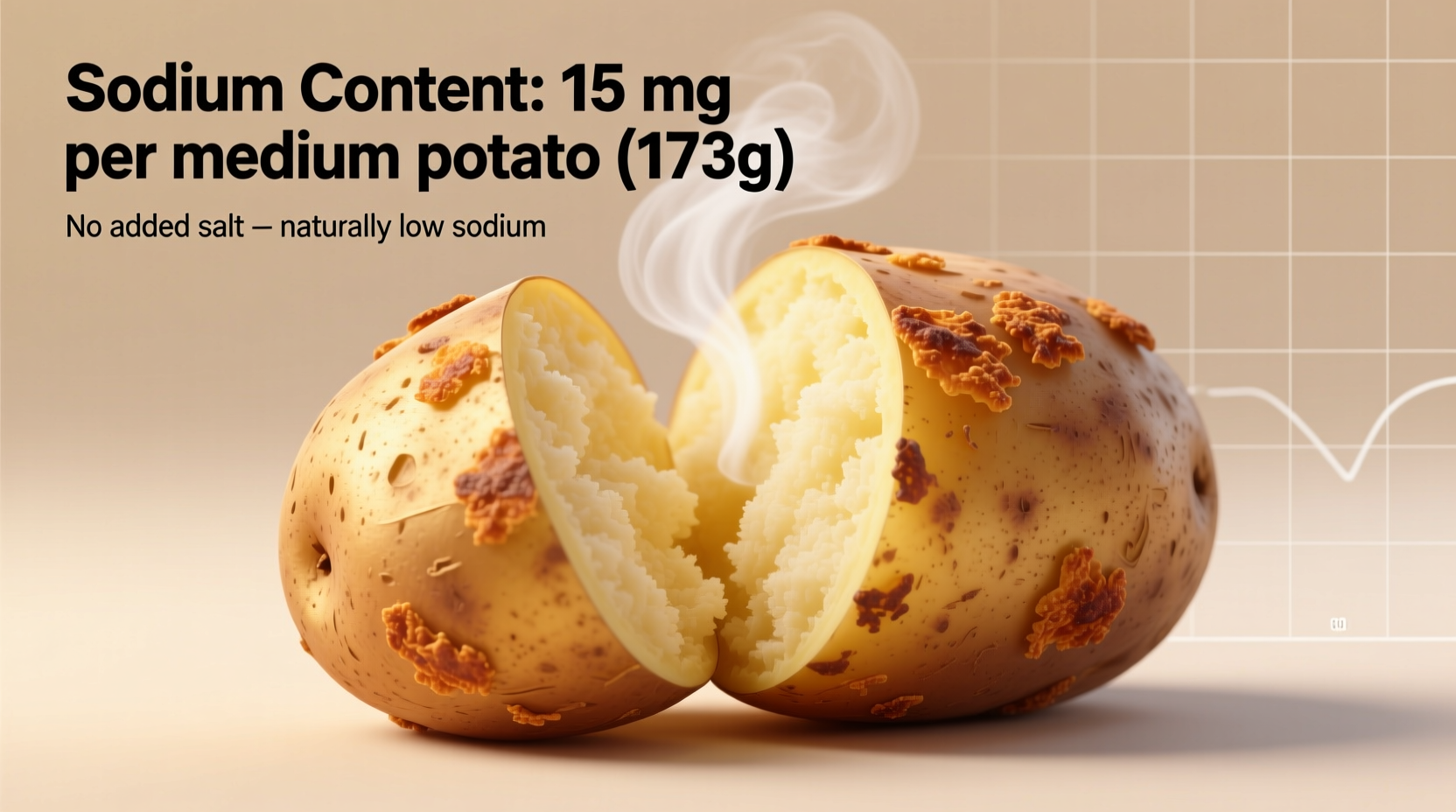A medium-sized baked potato (173g) with skin contains approximately 17-20mg of sodium naturally. This represents less than 1% of the recommended daily limit of 2,300mg. The actual sodium content increases significantly when salt or high-sodium toppings are added.
Discover exactly how much sodium you're consuming with your baked potato—and how preparation methods dramatically impact this number. Whether you're managing hypertension, following a heart-healthy diet, or simply tracking your nutrition, this guide delivers precise measurements from authoritative sources, practical serving tips, and science-backed strategies to enjoy this versatile vegetable while staying within healthy sodium limits.
Why Sodium Content Matters for Baked Potatoes
Potatoes themselves are naturally low in sodium, making them an excellent choice for heart-healthy eating. However, the way we prepare and serve them transforms this humble vegetable into either a sodium-friendly option or a dietary concern. Understanding these differences empowers you to make informed choices that align with your health goals.
Natural Sodium Content: The Baseline Facts
According to the USDA FoodData Central database, a plain baked russet potato (173g with skin) contains just 17mg of sodium naturally. This minimal amount comes from the potato itself, not from added salt. The American Heart Association recommends no more than 2,300mg of sodium daily, with an ideal limit of 1,500mg for most adults—particularly those with hypertension.
| Preparation Method | Portion Size | Sodium Content | % of Daily Limit (2,300mg) |
|---|---|---|---|
| Baked potato with skin (no salt) | 173g (medium) | 17mg | 0.7% |
| Baked potato with 1/4 tsp salt | 173g | 550mg | 24% |
| Baked potato with sour cream & bacon | 173g | 800-1,200mg | 35-52% |
| Fast food loaded baked potato | 300g | 1,500-2,000mg | 65-87% |
This comparison clearly demonstrates how preparation transforms a naturally low-sodium food into a significant source of dietary sodium. The data comes directly from the USDA's comprehensive food composition database, considered the gold standard for nutritional information in the United States.

Factors That Impact Sodium Levels in Your Baked Potato
Several variables affect the final sodium content of your baked potato:
Potato Variety and Growing Conditions
All common potato varieties (russet, Yukon gold, red) contain similar naturally occurring sodium levels. The USDA confirms minimal variation between types when prepared without added salt. Soil composition and growing conditions have negligible impact on sodium content compared to preparation methods.
Cooking Method Differences
Whether you bake, microwave, or boil your potato makes little difference to the natural sodium content. The critical factor is whether salt is added during cooking. Boiling potatoes in salted water can increase sodium absorption by up to 300% compared to unsalted water.
The Skin Factor
Leaving the skin on provides additional fiber and nutrients without affecting sodium content. The natural sodium is distributed throughout the potato flesh, not concentrated in the skin. Many health organizations, including the Mayo Clinic, recommend keeping potato skins intact for maximum nutritional benefit.
Practical Strategies for Managing Sodium in Baked Potatoes
Enjoy this nutritious vegetable while keeping sodium in check with these evidence-based approaches:
Smart Seasoning Alternatives
Replace salt with flavor-boosting alternatives that add zero sodium:
- Fresh herbs (rosemary, thyme, chives)
- Lemon or lime zest
- Garlic powder (check labels for sodium-free versions)
- Vinegar-based seasonings
- Smoked paprika for depth without sodium
Portion Control for Toppings
If using higher-sodium toppings, control portions carefully:
- Measure sour cream (2 tablespoons max)
- Choose low-sodium cheese alternatives
- Use bacon sparingly as a flavor accent, not a main topping
- Opt for fresh salsa instead of bottled varieties
Restaurant Ordering Strategies
When dining out, request your baked potato "prepared without salt" and ask for toppings on the side. Many restaurants automatically salt potatoes during preparation, adding 300-500mg of sodium before toppings are even considered.
When Baked Potatoes Fit Into Sodium-Restricted Diets
For individuals following medical sodium restrictions (1,500mg or less daily), plain baked potatoes remain an excellent option. The National Institutes of Health specifically recommends plain potatoes as "naturally low-sodium foods that form the foundation of heart-healthy eating patterns." Just be mindful of cumulative sodium from other meal components.
Registered dietitians consistently rank plain baked potatoes among the top vegetable choices for DASH (Dietary Approaches to Stop Hypertension) diets, which emphasize whole foods with minimal added sodium.
Debunking Common Sodium Myths About Potatoes
Several misconceptions persist about potatoes and sodium:
- Myth: All potato preparations are high in sodium
Fact: Only added salt and toppings increase sodium content significantly - Myth: Sweet potatoes have less sodium than white potatoes
Fact: Both contain similar naturally occurring sodium levels (15-20mg per medium potato) - Myth: Organic potatoes contain less sodium
Fact: Growing method doesn't affect natural sodium content
These clarifications come from the Academy of Nutrition and Dietetics' position paper on vegetable consumption, which emphasizes that preparation method—not the vegetable itself—determines sodium impact.
Putting It All Together: Your Sodium-Smart Baked Potato Plan
Follow this simple framework to enjoy baked potatoes while managing sodium intake:
- Bake potatoes without added salt
- Use the skin for added nutrition
- Measure high-sodium toppings (max 1/4 tsp salt = 550mg sodium)
- Pair with low-sodium protein sources like grilled chicken
- Balance your entire meal's sodium content
This approach aligns with recommendations from the American Heart Association's "No-Fad Diet" guide, which emphasizes whole foods prepared with minimal added sodium.











 浙公网安备
33010002000092号
浙公网安备
33010002000092号 浙B2-20120091-4
浙B2-20120091-4